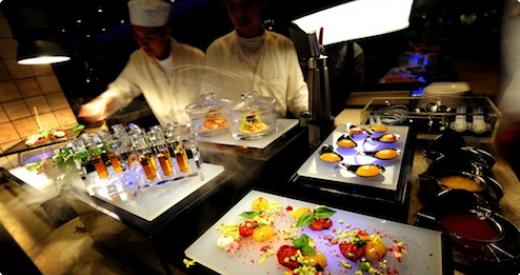
When Ferran Adria announced early this year his decision to close his three-star Michelin starred El Bulli restaurant in December 2011, many were shocked. He announced his plans to set up a non-profit research foundation and culinary academy offering scholarships to 20 visiting chefs. Well, his dream seems to be very much underway as a Spanish Telecom giant recently signed on board with his new teaching and research venture.
During Adria’s trip to Singapore last April, all his talks at the World Gourmet Summit were fully packed with foodies, restaurateurs and chefs. The famous chef remains to have a rock star following in Asia. But what does this mean for the future of Molecular Gastronomy?
Just when people expect molecular gastronomy to be fading away, Royal Plaza on Scotts , a hip and trendy hotel in Singapore, becomes the first buffet offering Molecular Gastronomy. The hotel’s Carousel Restaurant added an avant-garde section to its seven satellite open kitchens. Inspired by Adria’s culinary art, Executive Chef Abraham Tan and his team use techniques like spherification, turning liquid into caviar.
Partaking of molecular gastronomy in the past has always been an indulgence limited to expensive, fine-dining restaurants. But this forward-thinking hotel changes that by making it accessible and affordable (only SGD $58++ for the buffet on weekdays and SGD$70++ on weekends).
Chef Tan explains that this avant-garde counter was planned nine months ago, way before Ferran Adria’s visit to Singapore: “This is the first time avant-garde cuisine is available on buffet counters. We are also bringing the behind-the-scenes to limelight as the preparation process is crucial in providing insightful and interesting perspectives to this new set of culinary techniques. In addition, the behind-the-scenes of avant-garde cuisine are never demonstrated extensively in front of guests, even in fine-dining restaurants. The action adds depth to the food that the guests are consuming and heightens the dining experience for the guests.”
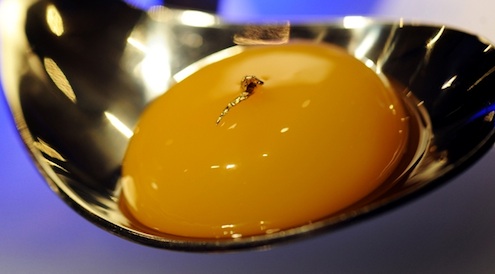
Mango Ravioli at Carousel
The diners keep coming back for his top five inventions:
Tomato Jelly Consomme, Shimeji mushroom with edamame beans; Mango Ravioli; 45 Degree Celsius Slow Cooked Sous-vide of Salmon with Passion Fruit Hollandaise; Chilled Goose Liver Pate with Valrhona Chocolate, Hazelnut crumbs; and Sixty Seconds Smoked Lobster Served with Apple Remoulade and Curry Apple Chutney Espuma.
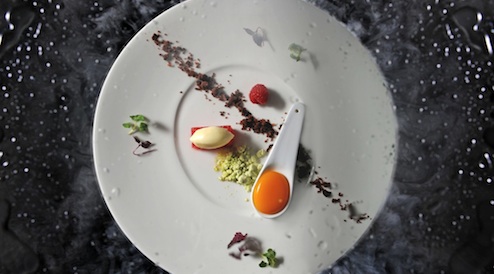
Compressed watermelon with mascarpone cheese, pesto crumbs, mango ravioli and cocoa crumbs
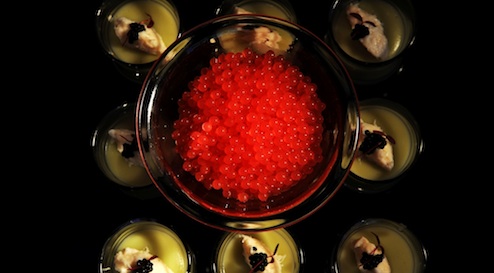
Watermelon Caviar, achieved through spherification
In the meantime, innovation and experimentation among Hong Kong’s chefs remain popular, although in more exclusive settings. Self-taught chef Alvin Leung, Jr continues to invent new dishes in Bo Innovation , oft-referred to as the El Bulli of Asia. The Mandarin Hotel’s Krug Room provides a front row seat to watch Chef Uwe Opocensky’s culinary creativity limited only to 12 guests seated in a communal table. There is no menu. As a true artist, chef Uwe trusts his inspiration to create each evening’s menu. Opocensky’s recent Eco Menu played deliciously with the concept or recycling. Each edible art installation makes the diner stop to think before partaking of the dish.
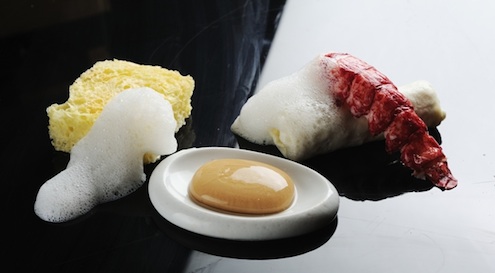
Chef Uwe’s Soap: Lobster/Bubble/Mushroom

Chef Uwe’s Metal Dessert
Perhaps, as Chef Ferran Adria shifts gears from being the top restaurant in the world to a non-profit research culinary academy, chefs in Asia would take their cue to make innovative cuisine more accessible to more people.
One thing is sure the experimental and innovative ways of Molecular Gastronomy will remain to have a lasting imprint in Asia’s vibrant restaurant scene.
Text by Maida Pineda. Photos courtesy of Royal Plaza on Scotts and The Krug Room of the Mandarin Oriental Hotel, Hong Kong.
Posted. 9 November 2010.









